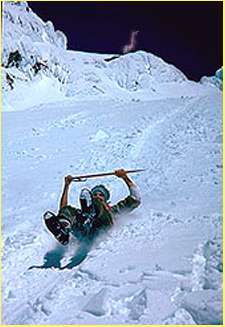 rising on the skyline!
rising on the skyline! rising on the skyline!
rising on the skyline!Seen here on Mt. Hood, the sitting glissade is the most popular and well-known form of the sport. Often climbers will specifically pack a sturdy piece of plastic to assist their swift downward slide. The ice axe is again a key piece of safety equipment for the glissade: a story will illustrate:
* "The unexplored East bowl of Mt. McLoughlin gleamed invitingly far below. They wanted it, they wanted to be first to walk its contours, they wanted to traverse it and attain the totally unknown NE ridge, but a steep couloir gaped beneath their feet, and, about halfway down, a series of large exposed rocks on the left brought sweat to their palms. They had not come prepared for anything quite this steep, and had no rope among them this day. After due discourse and a snack in the hot June sun, they put on all their most warm and waterproof clothing, carefully tucked all their clothing in tightly, and most carefully of all fastened down their gloves and mittens for protection from the rough abrading snow. All preparations for the flight now in order, they launched one at a time, the first man like a trial sacrifice to the Volcano God. In less than 5 minutes, he was to the bottom, and arose, triumphant, waving his axe above his head for the rest to follow."
"Flopping down on his stomach at the edge a half-melted cornice overhanging the couloir, the next man placed his ice axe into the textbook-perfect self-arrest position, and slowly inched his boots over the edge, dragging his axe point stoutly into the snow as a brake. He began to accelerate rapidly, far more rapidly than he'd anticipated. Quickly, he was blind with bitterly cold snow packed between his glasses and his eyes and striving to stuff his nose and mouth. It seemed he must have reached automobile speed, and avoiding the rocks halfway down was now academic, as he was blind and could only hope his initial angle had kept him in the center of the widening couloir. He thought only a few determined thoughts: "do not get flipped over, do not loose your grip on the axe, dig it in firmer!" Suddenly, the ride was over, and he stood up shakily, still blind, but waving his axe over his head for the last man to follow."
* Author's note: although
a true story, and illustrative of how a climber might utilize
the technique to descend a dangerous area in a survival situation,
the truth of this story is that these dummies ought to have given
up this very optional goal for the day, and come back some other
time with rope and pickets or snow flukes to anchor a safe descent.
This is summer Glissading on the upper slopes of The Husband Mountain, on the western edge of the Three Sisters Wilderness Area. Illustrated is the standing glissade, wherein the climber actually skis on the edges of his rigid mountaineering boots, and uses his ice axe as a sort of rudder. This takes some skill to master, as it is actually quite akin to downhill skiing, but keeps the climber much drier, and on rocky slopes diminishes the dangers of injury due to collision with rocks and other hard objects lying on, or just under, the snow surface. On the other hand, you are standing up, and if you get upset, you can take a potentially dangerous fall, so as always, consider carefully the risks and if you should undertake them.
Glissading is a great way to enjoy the beauty of a mountain in spring or even summer. Sliding down the mountainside on a piece of plastic can provide thrills, but sliding on the often steep, snowy and icy surface can be potentially dangerous for even the most experienced climber. With the prospect of having to avoid exposed rocks or flipping and careening out of control, much caution should always be observed. The route down, if not visible the entire way, should be viewed with extreme circumspection.